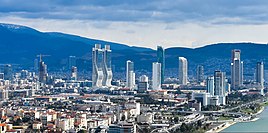| This article relies largely or entirely on a single source. Relevant discussion may be found on the talk page. Please help improve this article by introducing citations to additional sources. Find sources: "Aegean region" – news · newspapers · books · scholar · JSTOR (December 2018) |
| Aegean Region Ege Bölgesi | |
|---|---|
| Region | |
      | |
 | |
| Country | Turkey |
| Largest city | İzmir |
| Provinces | 8 |
| Area | |
| • Total | 85,000 km (33,000 sq mi) |
| • Rank | 5th |
| Population | |
| • Total | 10,477,153 |
| • Density | 121/km (310/sq mi) |
| Demonym | Turkish: Egeli |
| GDP | |
| • Total | US$ 102.807 billion (2022) |
| • Per capita | US$ 9,810 (2022) |
| Time zone | UTC+03:00 (TRT) |



The Aegean region (Turkish: Ege Bölgesi) is one of the 7 geographical regions of Turkey. The largest city in the region is İzmir. Other big cities are Manisa, Aydın, Denizli, Muğla, Afyonkarahisar and Kütahya.
Located in western Turkey, it is bordered by the Aegean Sea to the west, the Marmara region to the north, the Central Anatolia Region to the east, and the Mediterranean Region to the south.
Among the four coastal regions, the Aegean Region has the longest coastline.
Subdivision
- Aegean Section (Turkish: Ege Bölümü)
- Inner Western Anatolia Section (Turkish: İç Batı Anadolu Bölümü)
Ecoregions
Main article: List of ecoregions in TurkeyThe ecoregions of this region are all Terrestrial, more specifically Palearctic, and still more so, Mediterranean forests, woodlands, and scrub. Different parts are within the following classifications:
- Aegean and Western Turkey sclerophyllous and mixed forests
- Anatolian conifer and deciduous mixed forests
- Southern Anatolian montane conifer and deciduous forests
Provinces
Provinces that are entirely in the Aegean Region:
Provinces that are mostly in the Aegean Region:
Provinces that are partially in the Aegean Region:
Climate
| Aydın | ||||||||||||||||||||||||||||||||||||||||||||||||||||||||||||
|---|---|---|---|---|---|---|---|---|---|---|---|---|---|---|---|---|---|---|---|---|---|---|---|---|---|---|---|---|---|---|---|---|---|---|---|---|---|---|---|---|---|---|---|---|---|---|---|---|---|---|---|---|---|---|---|---|---|---|---|---|
| Climate chart (explanation) | ||||||||||||||||||||||||||||||||||||||||||||||||||||||||||||
| ||||||||||||||||||||||||||||||||||||||||||||||||||||||||||||
| ||||||||||||||||||||||||||||||||||||||||||||||||||||||||||||
The climate of the Aegean Region has a Mediterranean climate at the coast, with hot, dry summers and mild to cool, wet winters and a semi-arid continental climate in the interior with hot, dry summers and cold, snowy winters.
Gallery
-
Cove in Muğla, Akbük beach between Muğla - Milas
-
Nature's wonder Denizli, Pamukkale
-
 View of Kuşadası, Aydın
View of Kuşadası, Aydın
-
 Bodrum's cityscape is dominated by white buildings.
Bodrum's cityscape is dominated by white buildings.
-
 Sehir Island in Marmaris
Sehir Island in Marmaris
-
 Afyonkarahisar Castle
Afyonkarahisar Castle
See also
References
- "Statistics by Theme > National Accounts > Regional Accounts". www.turkstat.gov.tr. Retrieved 11 May 2023.
- Mark Cartwright. "Celsus Library". World History Encyclopedia. Retrieved 2 February 2017.
- "The Temple of Artemis at Ephesus: The Un-Greek Temple and Wonder". World History Encyclopedia. Retrieved 17 February 2017.
- "Statistics". Archived from the original on 2011-06-20. Retrieved 2011-05-30.
| Geographical regions of Turkey | ||
|---|---|---|
38°00′N 29°00′E / 38.000°N 29.000°E / 38.000; 29.000
This article about an Aegean Region of Turkey location is a stub. You can help Misplaced Pages by expanding it. |